Wendy Roberts (Imrie): We went on a School Christmas cruise 15 Dec 1965 - 1 Jan 1966.
| The itinerary was: Leave Southampton Call at Malta Arrive Beirut Arrive Haifa Leave Haifa Arrive Piraeus for Athens Leave Piraeus Arrive Genoa |
Wed 15 Dec Mon 20 Dec Thu 23 Dec Fri 24 Dec Sun 26 Dec Tue 28 Dec Wed 29 Dec Sat 1st Jan |
Travel from Genoa to London by special train, arriving Victoria approximately 3.0pm on Sunday, 2nd Jan.
Cost £51. Basic, including shore trips in Malta and Athens. [£739 in 2010, based on RPI]
Tours from Beirut and Haifa were extra, with a choice of A or B:
A. An overland tour by coach from Beirut through Syria, Jordan and Israel rejoining the ship at Haifa. The two nights ashore were spent in Old Jerusalem in boarding schools or religious guest houses. Amman, Dead Sea, River Jordan, Old and New Jerusalem, Bethlehem included. COST £10
B. A series of shorter tours spending the night on the ship.
1. Baalbeck - whole day tour from Beirut £2.0s.0d
2. New Jerusalem - from Haifa £2.2s.0d
3. Galilee - from Haifa £2.0s.0d
COST £6.2s.0d
Whichever you chose you could go on a tour of Haifa and district £1.5s.0d.
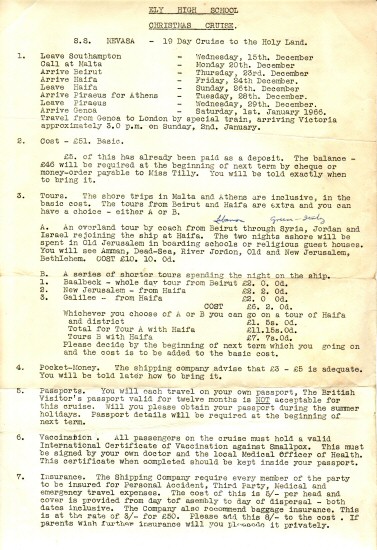 |
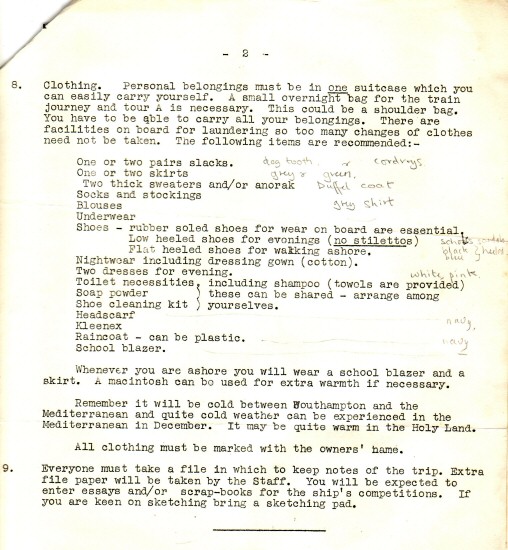 |
Note item 9: Everyone must take a file in which to keep notes of the trip. Extra file paper will be taken by the Staff. You will be expected to enter essays and/or scrap books for the ship's competitions. If you are keen on sketching bring a sketching pad.
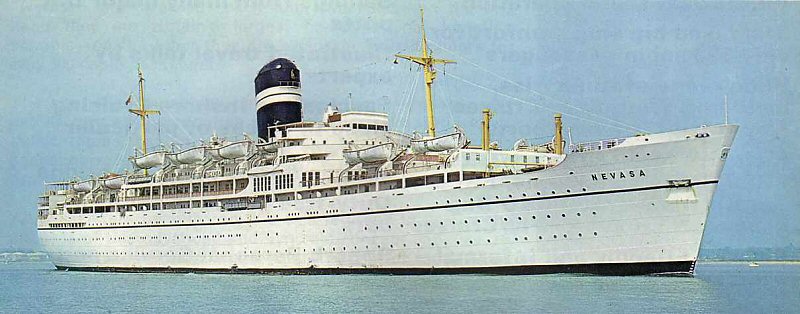
SS Nevasa - source http://www.ssuganda.co.uk/nevasa/index.html
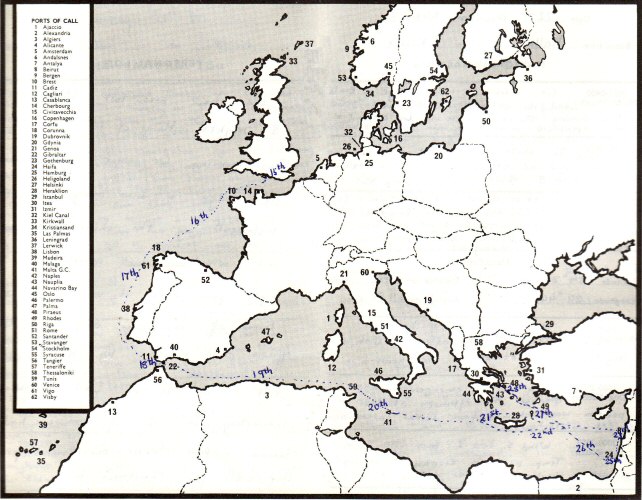
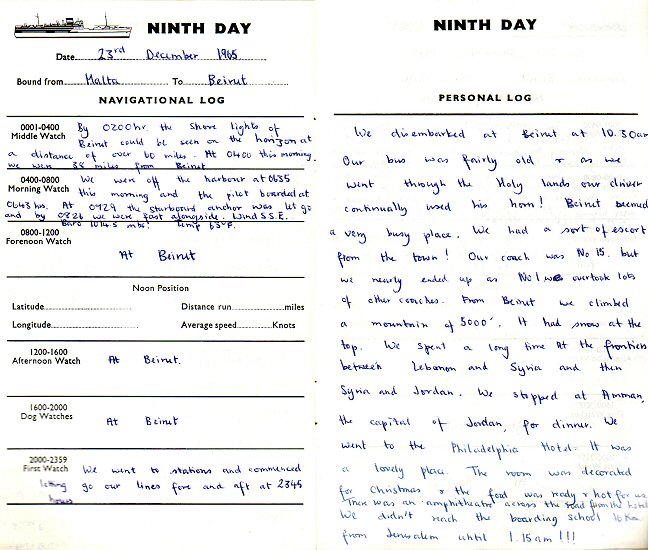
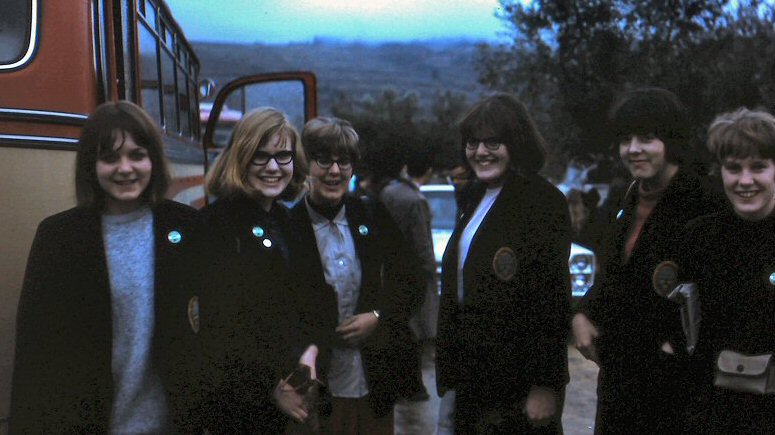
Day 10: On our way to Jerusalem: Ann Ladson, Janice
Watterson, Judith Robinson, Margaret Harwood, Judith Doe and
Monica Vince
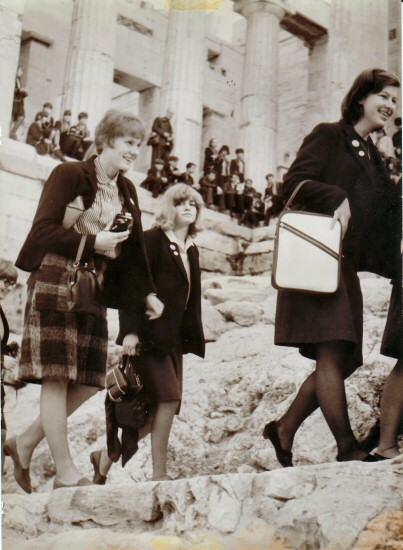
Day 14: at the Acropolis in Athens: (just in picture) Judith
Robinson, Monica Vince, Wendy Imrie, Mary Goodrich
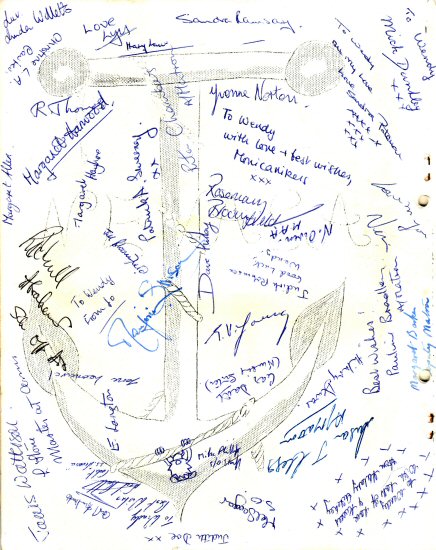
from the Ely High School Magazine 1965-66
CHRISTMAS CRUISE.
On December 15th, we set off with Miss Langton and Miss Dewar on our cruise to the Holy Land. After we arrived at Southampton, we were taken down to the docks, where we had our first sight of the "Nevasa".
The first few days on board were spent in finding our sea legs and our way around this miniature seatown. Having passed through the Bay of Biscay, we considered ourselves hardened sailors, although it was still rather disconcerting to watch the horizon heaving up and down while eating our breakfast. Although we had to attend certain organised periods each day, such as deckgames or lectures, they were presented in such a manner that we never lost interest. In the evening there was a choice of activities: dancing, sing-songs, quizzes or films. We particularly enjoyed the dances which were often held on deck under the Mediterranean sky.
Unfortunately we could not stop at Malta as we were behind schedule, but we were well compensated by the glorious weather we had in the next few days. Although the festive season was drawing nearer, it seemed most unlike Christmas as we sailed over shimmering seas. We had a strong contingent of musical souls with us, who made their way around the ship carol singing, and earned us the reputation of "the school that sings well".
We docked at Beirut on December 23rd, and then our party split up. Seventeen of us went on the overland tour with Miss Dewar, and the others went with Miss Langton on the shorter trips.
The Ship Based Tours
As we travelled through Beirut, we could see that it was divided into two sections: a slum area around the docks, and an area which had a large number of American buildings. Shanty towns could be seen on the outskirts; these were inhabited by Arab refugees. The coach slowly climbed the mountain slopes and passed orange groves with laden trees. Our destination was Baalbeck, which is a typical Arab settlement with tall buildings and narrow streets. The ruins of a Roman temple stand out from the plain; they cover a large area and are extremely well preserved. After exploring this beautiful monument we returned to the "Nevasa".
During the night, the ship sailed on to the port of Haifa in Israel. It is situated on the slopes of Mount Carmel. In the morning we left on our long journey to Jerusalem. The road first travelled parallel to the Mediterranean, through groves of bananas and Jaffa oranges. Then we left the sea to enter the dramatic scenery of the mountainous region of Israel. The only road which links the rest of Israel to Jerusalem passes through this region. The part which traverses a narrow gorge is called the Road Of Our Heroes; it received this name from the massacre of the Jewish teenage army which took place here during the establishment of present day Israel. On arriving in Jerusalem, we found parts of it very modern; this proved a disappointment to some.
On Christmas Day we travelled to Galilee, an extremely barren and hilly region with coarse grass as the only vegetation. This area has a number of Kibbutz, which are Jewish communal farms. Nazareth, our next stop, is situated on a hill slope which is dotted with Arab houses. As we walked to the Church of the Annunciation, we could see that the narrow streets sloped up the hillside. A hundred yards away is built a monastery which is placed over the house of Mary and Joseph after their return from Egypt. We travelled on to Capernaum, past the Sea of Galilee and then crossed over by boat to Tiberius. We travelled back to the ship and ate our Christmas dinner amidst a glorious sunset.
The Overland Tour
After a journey from the snows of the Lebanese mountains down to the Syrian plain, we arrived in Jerusalem early on the morning of Christmas Eve. After scarcely six hours' sleep, we were on the move once more to spend the morning in Old Jerusalem, which is the Jordanian sector. Here, we visited the Garden of Gethsemane, the Church of All Nations, Pilate's house and the Church of the Holy Sepulchre, which is supposed to be built on the site of Golgotha.
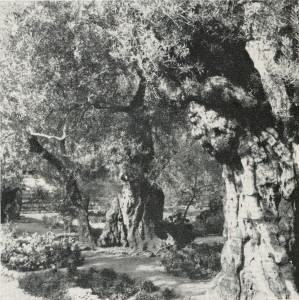
Olive Trees in the Garden of Gethsemane, Old Jerusalem
Rosemary Broomfield, U.VI
We made our way, rather awed, along the Via Dolorosa, walking in the very footsteps of Jesus as He carried His Cross. All around us milled children, traders and beggars, who tried with Eastern persuasiveness to interest us in their wares. In the afternoon we journeyed to Bethlehem, where we visited the Church of the Nativity; here, although obviously commercialised, one felt closest to that first Christmas. As we returned in darkness through the Shepherds' Fields, we saw the stars rise and cluster protectively over the little town.
On Christmas Day, we crossed the border into new Israeli Jerusalem in a blaze of sunshine. It was very sad and thought-provoking to see the division between the two countries as they faced each other hostily across the barrier. Most of us received a far better impression of Israel with its clean civilised houses than the dirtier and older quarter of Jerusalem. We were then whisked through the town to see The Shrine of The Book, where the Dead Sea Scrolls are kept.
Afterwards, we visited Mount Zion to see the splendour of David's 'Tomb and the small Church nearby. Round the tower of this church were ranged soldiers with machine guns who were surveying the small strip of no-man's land just below us. Descending once more, we were driven to Caesarea, where we saw the foundations of a Roman town and then we rejoined the rest of our party at Haifa.
The next morning all of us visited the Arab settlement of Acre and in the afternoon, the ship sailed on and docked at Piraeus on December 28th. We travelled by coach to Athens. As we climbed the slopes of the Acropolis, we could view closely the architecture of the ancient buildings and the honey-coloured columns of the Parthenon. The buildings have often been damaged in times of war, and it is amazing that so much remains. We then went on to see the changing of the guard outside King Constantine's Palace. In the afternoon, we shopped around Piraeus and tried our skill at bargaining with the local traders.
The next morning we sailed for Genoa and arrived there on December 31st. Many of the Schools then had to fly home, but we spent the day touring the villages of the Italian Riviera. The following morning, we boarded our 'plane at Genoa airport and flew back to England over the snow-capped Alps.
We all felt that this cruise was one never to be forgotten; we had made new friends, visited places which had hitherto been just names in a history book and had seen how the peoples of other countries live.
MONICA VINCE, V.I and
JANE LEONARD, V.2
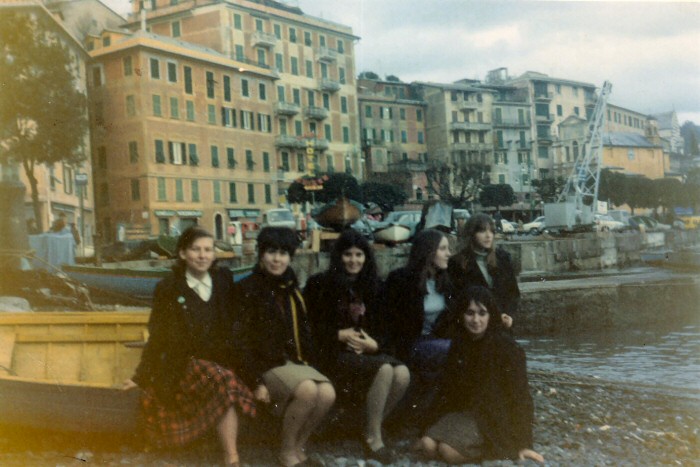
Margaret Cockburn (née Allen): This is at
Santa Marguerita, near Genoa on New Year's Day 1966 at the
end of the Holy Land Cruise on Nevasa. The girls are
my UVI friends, L to R: Mary Goodrich, Christine Carter,
Linda Willetts, Rosemary Broomfield, Gillian Bloomfield and
Margaret Hayhoe. We had to wear our school blazers whenever
we went ashore!
Links
SS Nevasa http://www.ssuganda.co.uk/nevasa/index.html
SS Nevasa - crew member website http://www.seadogs-reunited.com/Nevasa.htm
SS Nevasa book research http://www.voy.com/148833/
Images, unless otherwise stated: Wendy Roberts (Imrie)
If you can add to this page with more photos and
recollections please contact
us
page created 25 Nov 10, updated 10 May 11